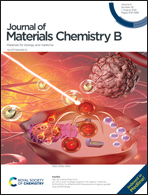Theranostic two-dimensional superparamagnetic maghemite quantum structures for ROS-mediated cancer therapy†
Abstract
In this work, size- and shape-controlled two-dimensional (2D) superparamagnetic maghemite (γ-Fe2O3) quantum flakes (MQFs) with high surface area and mesoporosity were prepared by facile hydrothermal synthesis for biological applications. These quantum flakes exhibited superparamagnetic behaviours over a wide temperature range of 75–950 K with high saturation magnetization of Ms – 23 emu g−1 and a lower coercivity of Hc – 6.1 Oe. MQFs also demonstrated a good colloidal stability and a positively charged flake surface. Selective toxicity dependent upon selective ROS scavenging/generation and cellular MQF uptake towards non-malignant human keratinocyte (HaCaT) and malignant melanoma (A357) and human breast cancer (MDA-MB 231) cell lines were witnessed. An increased ROS concentration resulted due to the peroxidase-like activity of MQFs in malignant cells. In contrast, ROS scavenging was observed in non-malignant cells due to dominant catalase-like activity. In vitro fluorescence properties added the diagnostic ability to the ambit of MQFs. Furthermore, the therapeutic efficiency could be significantly enhanced by the hyperthermic (25–47 °C) ability of MQF in cancerous cells. Our findings reveal the novel theranostic MQF structure with immense cancer therapeutic potential via augmentation of ROS generation by hyperthermia in a selective microenvironment.



 Please wait while we load your content...
Please wait while we load your content...